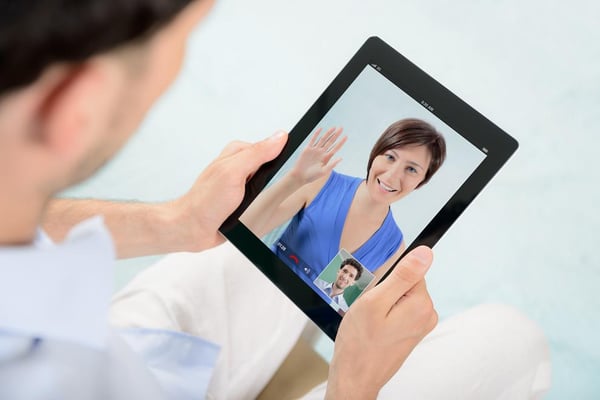Published on
New Technologies Make Students Participants Rather Than Recipients

The following interview is with Michael Olsen, engineering professor at Iowa State University. Olsen experienced great success after introducing videoconferencing software into his courses in the College of Engineering. In this discussion, Olsen explains how such technological advances have transformed his classes today, and how videoconferencing technologies will change the role of postsecondary students in 10 years’ time.
1. What were the biggest differences you noticed in your classes before and after you began using videoconferencing software?
One of the challenges we’ve been having with our courses here — and I think it’s pretty uniform across higher education — is class sizes have been growing substantially. There is a number of reasons for that; just simply increased enrollment, decreased resources available for education. The class sizes have gotten bigger.
As an example, the class I teach over the years has gone from, maybe, 50 students per section or at least 50 students per semester up to … over 160 students. And, so, the biggest impact of that is the one-to-one interaction with the students; being able to answer their questions. Especially teaching an engineering class, a lot of the classes [are] problem solving-based. And, so, whether giving homework assignments or practice problems for exams, or what not, a lot of students, they’ll have questions about that. “How do I set this up?” “How do I get started?”
There’s only so much time to be able to do that in class and there’s only so many ways to address that in the lecture. So that’s usually where office hours come in. … You assign a homework assignment and a couple of days later, students will come to your class and ask questions. But as class sizes get bigger and bigger, there’s only so many hours in the week to have office hours. … Of course, I have lots of other responsibilities besides just teaching this particular course.
And, so, I kind of thought of, “How do I interact better with the students? How do I manage my time better and also make myself more available to students?” And these online office hours, online office sessions have really made that possible. …
One of the biggest differences I’ve seen is that I have seen students have done better. Scores have gone up. They’re able to get the questions that they have answered. Students seem to enjoy it. … They really love this opportunity to be able to ask questions. They’re really appreciative; they understand that … I do this at home, after hours. And they appreciate that; they appreciate the time that I’m giving them from my home life to do this. But, to me, it’s just so beneficial I don’t mind doing that. It’s actually good for my students and it’s good for me because it allows me to interact with my students in that way.
2. How has it changed the way students are approaching the actual class, the weekly classes?
They still come to class. It hasn’t affected attendance at all. That might be one concern, “Oh, if students can get all this information online, would they come to class?”
They do come to class. In fact, if anything, I think maybe attendance is even better. Often, at times, attendance will drop in a lecture class when students get lost. They become so lost in class that they just feel it’s hopeless — they just stop coming — and that doesn’t happen anymore. I see attendance has gone up because students are able to remain up to date on the material. … I don’t think of this as necessarily replacing the lecture format, but I do see it as supplemental.
Now, one area that I see [as] beneficial is that there’s a movement here and across the country and, I guess, the world, to have more online-type courses. We do that, the course that I teach, we actually have an online section of it. And so, what the online section is: we’re starting small right now but out of my students maybe 15 of those are distance education students. So, my lectures are recorded online and then those are posted online also. So there are a bunch that are recorded and posted online so when I actually do the notes in class, those are on a smart board, so online students can see that also. Now, the biggest drawback to being a distance education student is that in a traditionally-taught class, they wouldn’t have the access to the professor that other students have. Students that are on campus, they can come to my office hours, they can ask me questions after class, because I’m there. I’m a live person; they’re there. Students that are watching these recorded lectures online with distance education — they don’t have that resource available. And, so, these online help sessions and office hours, they’re really important to those students, because some of these students can be halfway around the world. I’ve had some students that have taken my classes that are in the military and they’re based in the Persian Gulf or someplace, and they’re watching my course online. And of course there is no way for them to interact personally with me. But they can do that with these … online help sessions.
So, I think that it’s maybe not necessarily changing the way we interact, but … I think it’s going to be an important tool that others might want to emulate as we go forward and, really, this idea of distance education of the virtual classroom, as that grows, I really think that this is something that other professors really might want to consider. Because there’s only so much that you can do with the lecture itself; that’s not necessarily interactive. It’s important because that’s where you present the material, but as students are trying to go through the material themselves and learn how to do problems, they really need to have an opportunity to ask specific questions they might have and this provides that opportunity.
3. What kind of impact did the use of such technology have on your use of time, both inside and outside of class?
It’s been a savior for me as far as time goes. It’s made me much more productive. That might sound counterintuitive because you might think, “Wow, in addition to everything else he’s doing, he’s doing these online help sessions.” Well, it saves me time in so many other areas.
I’ve found that students like these online help sessions so much that my actual students coming to my live help sessions has actually gone down. I mean, students will still do that, they want that one-on-one interaction, but it’s also beneficial too because … whenever you have a question, this is very common, people think this is a silly question, “I shouldn’t ask this question,” and people are embarrassed to come over to office hours or embarrassed to ask a question in class because they think it’s a silly question. And of course there are no silly questions; if you don’t understand something, ask the question, get the answer. What the online help sessions do is, the people that are afraid to ask questions, when we set these online help sessions, everyone logs on anonymously. … And so, they’re students and they … use this fake name and therefore they’re not afraid to ask a silly question because they know that it’s not going to get back to them. They can ask whatever they want. And when I first did this, I was concerned, well if everyone is logging on anonymously, maybe people are going to be rude, maybe they are going to be disruptive, because they can do those types of things anonymously. They don’t do that. It doesn’t happen at all; students, they’re very respectful, they’re very appreciative that we’ve taken this time making this available to them that the students have actually been wonderful. They show a lot of respect for both me and their classmates with these online office hours and help sessions. …
It’s actually freed up a lot of time for other students. Sometimes office hours … there’s a certain period of time, you have a question but if there’s a lot of students waiting to see the professor, the student’s time is wasted. They are sitting outside the office, waiting for their opportunity to ask questions and here, they’re interacting the whole time, the whole time we have the online help session, they’re interacting, they’re not just standing around waiting for their chance to see their professor. So I know it’s been beneficial for my time and I think it’s also beneficial for the student’s time.
4. How would the increased use of videoconferencing technology impact the role of higher education instructors in 10 years’ time?
I think where this fits in is, as we grow this idea of teaching courses over the internet, teaching courses remotely, I think that’s where this technology has an impact and has an increased role.
I don’t think that the traditional university is ever going to go away. There’s just too much benefit to actually go into a university and then residing there and taking courses and interacting with professors and other students. Really, it’s just a part of life. But the online courses have grown and will continue to grow because people’s lives move quickly. And there are students that, they’re doing something else and they still want to be able to take classes, want to be able to get their education. So as that part of our mission grows, I really see that’s where these technologies are going to increase. If we’re going to provide educational opportunities in courses over the internet, we have a responsibility to … make those opportunities as good for the student as possible.
We can’t make it so it would be basically two classes of students; one on campus and one off campus. And I think these types of technologies are going to allow us to basically make sure that — maybe not the same opportunities, but similar opportunities — similar educational opportunities, as far as interacting with instructors, exists for students that are taking this course remotely, like I said, perhaps on the other side of the world, and students that are actually physically on campus.
So, I think that’s really where I see these technologies impacting. The whole idea of online education and internet courses is evolving. Those have just begun and we’re still trying to figure out exactly how they’re all going to work. And I’d like to think, or I hope, that technologies, such as the ones I’m using, play an integral part as we work our way through this, figure out how we’re going to make those distance education opportunities as beneficial as possible.
5. How will the use of videoconferencing technology impact the role of students in 10 years’ time?
… I actually see this as changing the role of students in some ways from less of a simply a consumer, but also a participant in the education.
What I mean by that is, when I teach class, when I have just regular office hours, the interaction is always just between me and the student. In different courses, you’re able to teach in different ways; if you’re teaching a literature courses, there’s a lot of student participation, discussion and things like that. That’s always been the case in those types of courses. It’s a bit more challenging to do that in an engineering- or a physics- or a science-type course. Those have really stayed in this old-model of instructor lecturing and then the students receiving the information and then feedback by exams and labs and homework and things like that.
When I have these help sessions, I see a lot of interaction between the students. What happens is, as I mentioned, the way the students ask questions is, they ask the questions in these chat windows and, so, the questions can sort of pile up. I’ll say, “Does anybody have questions?” and I get five questions right away. And I’ll sort of go through those questions as they ask, one by one, and then I’ll eventually get to every question, but what will happen is, sometimes, as I’m answering some questions, other students will take the initiative to answer other students’ questions. And I don’t see that in class. That doesn’t happen. As I’m lecturing and somebody asks me a question, students don’t typically answer that question themselves. … Students don’t take the initiative and don’t just yell things out.
Here, they do that and where as … yelling out in class, this is actually kind of rude and interrupting the instructor, here they’re not doing that because it’s sort of in this chat window, it’s sort of a separate conversation. And so … this technology in some ways makes the students take more of a lead role in helping their peers and educating their peers.
And I don’t even know what happens outside. The way this technology works is, students are able to have side conversations. You can have, students can have, this sort of public chat window where I’m in, where they’re asking me questions and I’m answering those questions publicly, but you can actually address and have chats with other students in this help session or other students privately. And I don’t know, for all I see, these students interacting and answering other students’ questions in the main window, but they may also be doing this in these … side windows. I think in some ways this technology and, actually, maybe I should encourage this more and encourage students to do this.
It actually makes it possible for students to interact with each other in ways that aren’t necessarily easy or possible in a regular classroom. … I think we’ve just kind of scratched the surface of that. And in some ways, this can make the students much more interactive and they can ask questions of each other, they can answer questions, they can interact privately, answering questions that perhaps I haven’t got to yet. …
I think it actually makes [students] much more interactive.
6. Anything you’d like to add about the value of videoconferencing technology to the roles of students and teachers in higher education, and how it might evolve in a decade’s time?
I know it’s going to play a bigger role. It’s played a bigger and bigger role in my classes every semester. I started on a trial basis and it’s just really ballooned from there. And I know the students love it. …
It’s unchartered territory right now. What I would encourage right now is, I really encourage my fellow instructors to give this technology a try. The students seem to love it. … Sometimes, we’re a little reluctant to try new things as instructors who have been doing things a certain way for so long, and we’re a little afraid of changing things; things have worked so well for so long.
This is one of those where I’m glad I made the change. It was a little challenging at first to get it to work out, but once I worked the bugs out, it has just been, it’s been wonderful for my students and wonderful for me so I really would encourage any instructors out there, any students out there, to look into this technology and give it a try in your classes.
Author Perspective: Educator



